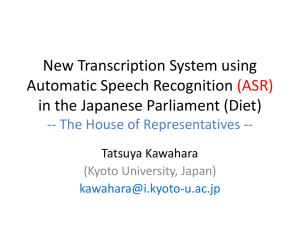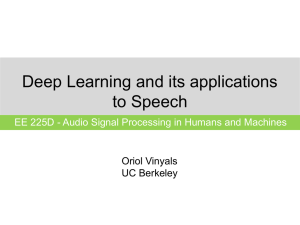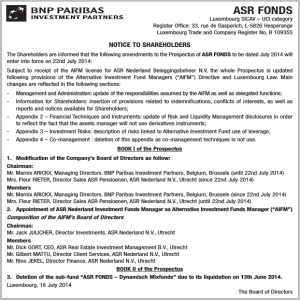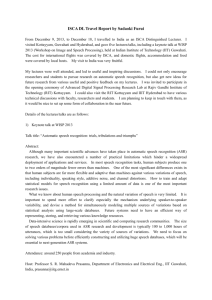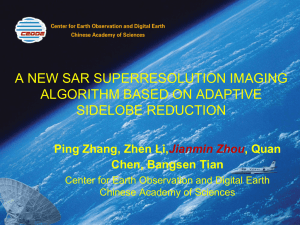Getting Started With ASR
advertisement
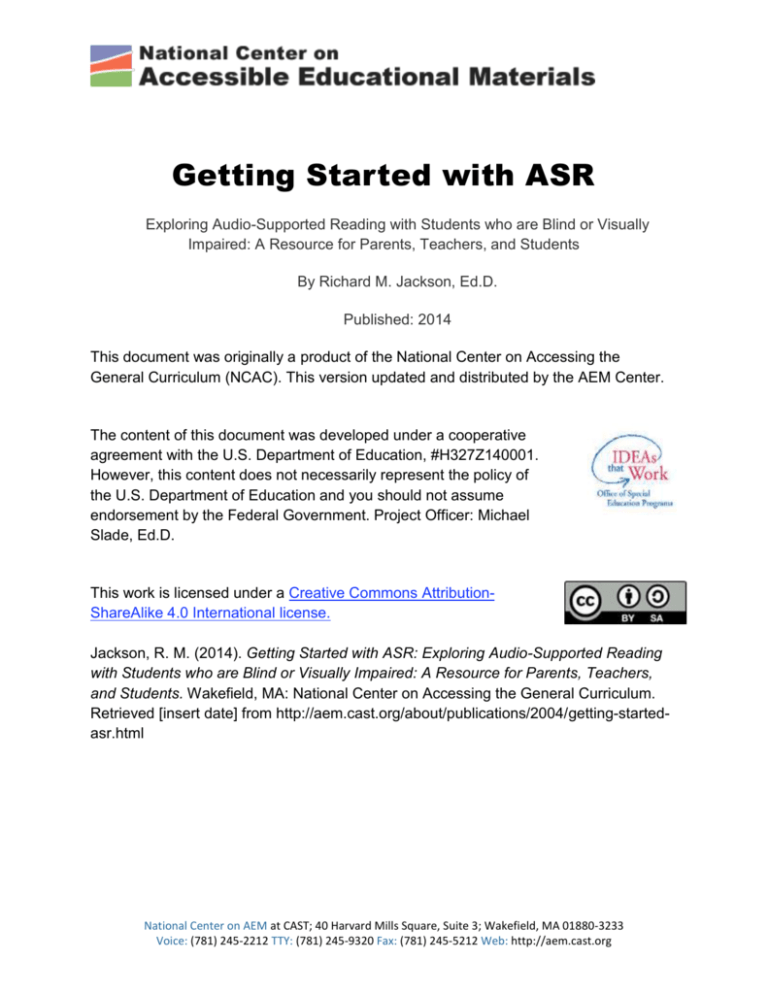
Getting Started with ASR Exploring Audio-Supported Reading with Students who are Blind or Visually Impaired: A Resource for Parents, Teachers, and Students By Richard M. Jackson, Ed.D. Published: 2014 This document was originally a product of the National Center on Accessing the General Curriculum (NCAC). This version updated and distributed by the AEM Center. The content of this document was developed under a cooperative agreement with the U.S. Department of Education, #H327Z140001. However, this content does not necessarily represent the policy of the U.S. Department of Education and you should not assume endorsement by the Federal Government. Project Officer: Michael Slade, Ed.D. This work is licensed under a Creative Commons AttributionShareAlike 4.0 International license. Jackson, R. M. (2014). Getting Started with ASR: Exploring Audio-Supported Reading with Students who are Blind or Visually Impaired: A Resource for Parents, Teachers, and Students. Wakefield, MA: National Center on Accessing the General Curriculum. Retrieved [insert date] from http://aem.cast.org/about/publications/2004/getting-startedasr.html National Center on AEM at CAST; 40 Harvard Mills Square, Suite 3; Wakefield, MA 01880-3233 Voice: (781) 245-2212 TTY: (781) 245-9320 Fax: (781) 245-5212 Web: http://aem.cast.org GETTING STARTED WITH ASR Introduction Audio-Supported Reading (ASR) is a technology-based approach for accessing and working with text presented in either braille or enlarged (magnified) print. This approach allows a user to listen to a spoken version of text while looking at screen-displayed print or while touching braille. In ASR, both the rate of information pick up and the portion of attention paid to braille or print—in combination with speech—can be controlled by the user. With sufficient practice, both braille readers and magnified print readers can greatly increase the rate at which they move through text using ASR. For many students with visual impairments who read either braille or print, the rate at which information can be gained using vision or touch without audio support can be frustratingly slow, especially when compared to reading rates achieved by typically seeing readers. Historically, learners with visual impairments have supplemented their direct access to braille or print by listening to talking books or other pre-recorded audio sources of text. The need to access the general education curriculum through text while keeping pace with typically sighted classmates has traditionally required two separate pedagogies: initially addressing learning to read either braille or print and then later learning to acquire information through listening. Today, technologies are widely available that easily afford the opportunity to combine the reading of either refreshable braille or screen-displayed text with vocalized or synthesized speech, leaving the relative contribution of either modality (vision/touch or audition) up to the discretion of the learner and the learner’s determination of the demands of the reading task. When the reading task demands close scrutiny, the reader may rely predominantly on either vision or touch, but when the task involves text that is familiar or highly predictive, the reader may rely disproportionately on listening as a support for comprehension. Moreover, if the reader is able to adjust the listening rate on the fly, the benefits of balancing the reading of braille or print with listening are made all the more striking. Technologies that currently enable the use of ASR are wide ranging. Some are free; some are available for trial; some are relatively inexpensive; others require considerable investment. Some technologies have a direct, intuitive feel while others have a relatively steep learning curve. Some technologies are feature-lean while others are bloated with complexities that few users may need to employ. With the increased availability of digital text as accessible instructional materials (AIM) for learning, parents, students, Getting Started With ASR | 2 teachers, and decision-making teams are challenged to make prudent and wellinformed decisions about the acquisition and use of technologies for accessing and working with digital text. The purpose of this document is to identify a few simple technology tools (hardware and software) that will allow students, parents, and teachers to try out ASR first hand to determine if ASR’s presumed advantages are useful to, and thus appropriate for, particular learners with visual impairments. Resources available for investment of time and money will have an impact on choices for the selection of technology tools that will vary by user or user group. This resource is intended to increase the comfort and confidence with which such decisions are ultimately made. The ASR Experience The simplest and perhaps most familiar pairing of audio with the reading of text is the “read aloud” process where a student reads either braille or print while a model such as a parent, teacher, or peer reads the same text out loud. The model can be familiar with the reader’s level of proficiency and can read aloud at the reader’s level or just beyond. A good model reads with drama—pausing, accelerating, exclaiming, and intonating appropriately. The reader is “forced” to follow along, picking up and extracting features in the text that correspond to the vocal productions of the model. The “read aloud” activity is used to build reading fluency, a critically important literacy skill that correlates highly with reading comprehension or making meaning from text. A reading model may increase their reading speed to encourage the student to recognize text as chunks of visual or tactile information and not be slowed by the need to decipher each character/letter/cell individually. The “read aloud” and its many forms is today a standard literacy practice in schools. Audio-assisted reading (AAR) for struggling readers is an approach similar to the read aloud but represents some of the earliest applications of technology. Students who have difficulty decoding or rapidly naming words may employ pre-recorded versions of a text to stand in for a reading model. These kinds of reading interventions have been found in some cases to help readers who struggle with decoding or rapid word identification to gain improvements in fluency after audio assist is withdrawn. In this instance, prerecorded audio is viewed as a scaffold to be removed after sufficient fluency and comprehension is established. In contrast, with ASR, audio is viewed as a support that will remain available via technology for a learner to use selectively, depending on the nature of their reading task. Getting Started With ASR | 3 Many students with visual impairments generally read at rates that are much slower than those of their non-impaired peers, regardless of whether they have difficulties with decoding, rapidly naming words, or vocabulary. These comparatively slower reading rates are attributable to the relative inefficiency of the impaired visual system or the haptic system for deciphering braille. While decoding and word naming remain critical components of literacy development among learners who are visually impaired—as with all individuals learning to read—augmenting the flow of text from either braille or print sources through listening has both practical and intuitive appeal. What follows is a simple procedure recommended for exploring ASR and discovering first hand its potential benefits. Preparation To authentically experience ASR, a user must have content provided in a digital text format and appropriate voice-synthesizing hardware and/or software. Digital text is electronic text that can be delivered via a computer or another technology device. Technology used must have capabilities of providing screen magnification with text-tospeech and/or refreshable braille with speech synthesis. Initially, a teacher of students with visual impairments or an assistive technology (AT) specialist can be particularly helpful in finding the best combination of ASR tools and features for a particular student. The best way to prepare for ASR exploration is for educators and/or parents to employ their knowledge and understanding of their student’s strengths and vulnerabilities in choosing an ASR scheme. In making such a general assessment, educators/parents should keep in mind their student’s current familiarity with various technologies as well as their level of success or lack thereof with their current reading medium (print or braille). Practical considerations for an initial trial of ASR should include the following: Material for use in an ASR exploration should be of high interest to the student and should not be challenging in and of itself for initial ASR. A time and place should be set aside for both educators/parents and student to focus their undivided attention on ASR, including a quiet workspace where interruptions will not occur. Computer, laptop, or handheld device (tablet or smartphone) as well as software, refreshable braille display, and/or other components of the ASR exploration should be gathered and tested prior to the student’s initial try-out to ensure a smooth first use. Getting Started With ASR | 4 Educators/parents and student should plan to work together as a team in trying out ASR features and discussing and comparing their differences and usefulness. Exploration of Technology and ASR What follows are just a few examples of the numerous technologies that are available for exploring ASR and its potential benefits. The first four examples are tailored to students with low vision while the fifth focuses on technologies for students who use braille as their primary literacy medium. Example One: PC or Mac with NaturalReader Begin with a PC or a Mac, and a large screen monitor and/or screen magnification software such as the “magnifier” provided by Microsoft’s Ease of Access Center (which is built into the Windows operating system). Download and install the free version of NaturalReader from NaturalSoft, Limited. Paste in some sample text for an initial trial. Note that the free version of NaturalReader has voice options and variable speed control. Note also that on-screen text is highlighted as it is read aloud. Encourage the student to both look and listen. Looking can be for navigation and spatial context purposes and listening can be for rapid pick up of the message contained in the text. Try looking alone and listening alone. Then ask the student to blend the two modes: looking and listening. Note differences in reading speed, posture, and head and eye movements. Ask the student to decide which reading assignments would be best accomplished using looking alone, listening alone, and ASR. Example Two: iPad with Read2Go or Voice Dream Reader Using an Apple iPad, install Read2Go or Voice Dream Reader. Both apps have features that will allow the user to discover the potential benefits of ASR. There is a free “light” version of Voice Dream Reader that allows access to a multitude of digital formats. As with NaturalReader, follow a similar strategy to explore the relative advantages of looking and listening alone and together. These are tablet applications and may serve entirely different functions for reading than do PCs. Getting Started With ASR | 5 Example Three: PC with ZoomText with Speech A more elaborate example for use with a PC incorporates an application called ZoomText with Speech from Ai Squared. ZoomText contains an exhaustive set of features that allows the user to set up an interface that precisely tailors display colors, magnification, and speech settings to match their preferences and needs. Using key commands, magnification level and speech rate can be adjusted on the fly.These are highly desirable functions as the user is able to apportion the amount of attention to be paid to listening and looking while within a specific reading task. View a brief video demonstration (link coming soon). Example Four: Smartphone or Tablet with GoRead With the Android operating system, ASR can be examined using either a tablet or a smart phone. The GoRead app allows simultaneous magnified text and voice access to a wide range of digital formats. Text size adjustments and voices are supplied by the Android operating system, while the GoRead app synchronizes speech with highlighted chunks of text. This is a highly portable application of ASR, but made all the more accessible for individuals with low vision with some of the more recently available 5+” screens on smart phones. Getting Started With ASR | 6 Example Five: BrailleNote with Refreshable Braille and Synthesized Speech ASR can also be implemented using a refreshable braille display and speech synthesis. Using BrailleNote’s voice output, a user is able to guide the device and media navigation while at the same time tracking across lines of refreshable braille. Check out this Bookshare How-To video showing a student using BrailleNote, and note how the student reads the braille output while listening to the text. Additional Technology Resources for ASR Keeping abreast of available hardware and software is a major challenge. There are innumerable text-to-speech software programs and hardware devices available in the marketplace, and many of these are regularly upgraded with changed or added features. The items described above are meant to be simply a few examples of the kinds of tools available. For further exploration of technology, investigate the Digital Content and Media Sources page on the AEM Center Another useful resource to help users decide on individual settings for text readers is the AIM Explorer, a free simulation tool that combines digital text with access features common to most text readers and supported reading software. Settings for magnification, text and background colors, text-to-speech options, highlighting, and layout options can be changed to find the best configuration for access to and understanding of text. Conclusion This document provides potential users of ASR and their parents and/or teachers with examples and procedures for exploring the potential of listening while reading for the purpose of increasing efficiency in tasks dependent on access to information contained in text. Getting Started With ASR | 7 Testing and trying various combinations of tools and resources will yield the best results for users. Options described are meant to provide those new to ASR with enough information to get started quickly and easily. Getting Started With ASR | 8
